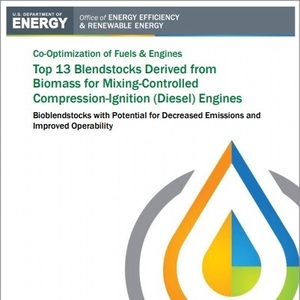DOE: Better bioblendstocks for cleaner diesel vehicles

August 5, 2021
BY U.S. Department of Energy
There’s no driving around it: most vehicles on the road today are still powered by gasoline and diesel fuels that create and emit greenhouse gas emissions. But new fuel blendstocks from biomass and waste resources, combined with advanced engine designs, are bringing us ever closer to a vision of clean transportation. Achieving this vision is critical for meeting our nation’s renewed goals for reducing greenhouse gases in the atmosphere to address climate change.
The Co-Optimization of Fuels & Engines (Co-Optima) initiative, supported by the U.S. Department of Energy Bioenergy Technologies and Vehicle Technologies offices, is conducting research to help the nation achieve this vision. Co-Optima combines experts from national laboratories, universities, and industry to drive innovations in fuels and engines toward better fuel economy and vehicle performance while reducing emissions.
A new Co-Optima report identifies the top 13 blendstocks created from waste or biomass for use in diesel fuel that could not only reduce greenhouse gas emissions but could lower the total cost of ownership of diesel vehicles. The benefits stem from three key areas of improvement across diesel system operations:
Advertisement
•Less soot in engines, which reduces the complexity and expense of emissions control systems.
•Improved hardiness in cold weather, with which some biodiesel engines struggle.
•Higher cetane number, which eases blending into fuel refinery processes.
To arrive at their top 13, researchers identified the key biofuel properties that could reduce particulate matter and nitrogen oxides—two of the four criteria pollutants regulated by the U.S. Environmental Protection Agency—by enabling changes to engine operation. Candidate blendstocks were screened against these and other critical fuel properties to determine which had the greatest potential for performance improvements. The list was finalized by determining the blendstocks that could reduce greenhouse gas emissions by at least 60% relative to petroleum diesel. The results provide a solid scientific basis to explore larger scale production of the most promising blendstocks for testing in multicylinder engines.
Advertisement
The comprehensive analysis was conducted by more than three dozen researchers from nine DOE national laboratories. The report, “Top 13 Blendstocks Derived from Biomass for Mixing-Controlled Compression-Ignition (Diesel) Engines: Bioblendstocks with Potential for Decreased Emissions and Increased Operability,” was coordinated by Dan Gaspar, a bioenergy researcher at Pacific Northwest National Laboratory and the leader of the Co-Optima initiative. For more details, please see the PNNL article.
Related Stories
The USDA maintained its outlook for 2025-’26 soybean oil use in biofuel production in its latest World Agricultural Supply and Demand Estimates report, released Aug. 12. The forecast for soybean oil prices was also unchanged.
U.S. soybean production for 2025 is forecast at 4.29 billion bushels, down 2% when compared to last year, according to the USDA National Agricultural Statistics Service’s latest monthly Crop Production report, released Aug. 12.
California’s new specified source feedstock attestation requirement: A critical new compliance step for renewable fuel producers
As of July 2025, California’s SCFS requires renewable fuel producers using specified source feedstocks to secure attestation letters reaching back to the point of origin. This marks a significant shift in compliance expectations.
At the University of Missouri, plant biochemist Jay Thelen is using arabidopsis as a powerful model to explore ways to boost oil production — an important step toward creating more sustainable, plant-based energy sources.
Iowa farmers have a new market opportunity for their 2025 soybean crop. Landus is expanding its Clean Fuel Regulation initiative, made possible by recent policy changes expected to increase Canada's demand for liquid biofuel.
Upcoming Events










